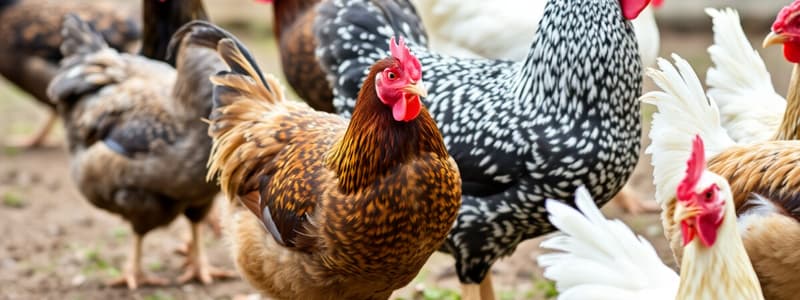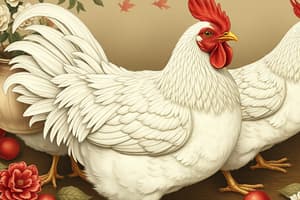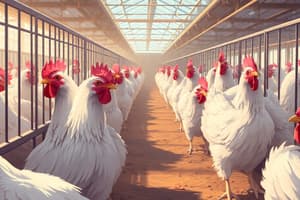Podcast
Questions and Answers
If you observe that chicks have visible wattles but no combs, approximately how old are they likely to be?
If you observe that chicks have visible wattles but no combs, approximately how old are they likely to be?
- Older than 5 weeks
- Between 8 and 12 weeks
- Around 4 weeks
- Less than 3 weeks (correct)
A farmer notices that their mature hens have small, pale combs and wattles. What might this indicate about the hens?
A farmer notices that their mature hens have small, pale combs and wattles. What might this indicate about the hens?
- They are at their peak egg-laying age
- They are likely sick
- They are ready to lay eggs
- They are non-laying birds (correct)
Which characteristic is commonly associated with Leghorn chickens?
Which characteristic is commonly associated with Leghorn chickens?
- Dual-purpose breed
- White eggshells (correct)
- Brown eggshells
- Origin in Japan
A farmer wants chickens primarily for meat production and selects Cornish chickens. What characteristic makes Cornish chickens a good choice for this purpose?
A farmer wants chickens primarily for meat production and selects Cornish chickens. What characteristic makes Cornish chickens a good choice for this purpose?
Which breed is known for having a Cochin-type body shape with buff Columbian colored plumage and was developed by removing leg feathers from another breed?
Which breed is known for having a Cochin-type body shape with buff Columbian colored plumage and was developed by removing leg feathers from another breed?
If a farmer observes that their chicken has a bright red comb, what does this likely indicate?
If a farmer observes that their chicken has a bright red comb, what does this likely indicate?
Which of the following chicken breeds is known for being developed in the Mediterranean area?
Which of the following chicken breeds is known for being developed in the Mediterranean area?
Which of the following breeds is considered a dual-purpose chicken, raised for both meat and eggs?
Which of the following breeds is considered a dual-purpose chicken, raised for both meat and eggs?
What is one of the primary functions of combs and wattles in chickens?
What is one of the primary functions of combs and wattles in chickens?
Which dual-purpose breed was born out of a specialized selection from the Rhode Island Red?
Which dual-purpose breed was born out of a specialized selection from the Rhode Island Red?
Flashcards
Egg/Layer Type Chickens
Egg/Layer Type Chickens
Chickens raised specifically for laying eggs.
Meat Type Chickens
Meat Type Chickens
Chickens intended for meat production.
Dual Type Chickens
Dual Type Chickens
Chickens intended for both egg and meat production.
Fancy Type Chickens
Fancy Type Chickens
Signup and view all the flashcards
Game Type Chickens
Game Type Chickens
Signup and view all the flashcards
Functions of Combs and Wattles
Functions of Combs and Wattles
Signup and view all the flashcards
Leghorn
Leghorn
Signup and view all the flashcards
Minorca
Minorca
Signup and view all the flashcards
Brahma
Brahma
Signup and view all the flashcards
Plymouth Rock
Plymouth Rock
Signup and view all the flashcards
Study Notes
Animal Production: Poultry Strains
- There are different types of poultry that can be raised for broiler, layer and breeder.
Types of Chicken by Purpose
- Chickens are categorized based on their purpose: egg/layer, meat, dual, fancy, and game types.
Egg/Layer Type Chickens
- These breeds are raised specifically for laying eggs.
Meat Type Chickens
- These breeds are raised for meat production.
Dual Type Chickens
- These breeds are raised for both egg and meat production.
Fancy Type Chickens
- These breeds are raised for aesthetic value.
Game Type Chickens
- These breeds are raised for game purposes.
Combs and Wattles in Chickens
- Combs and wattles are important features in chickens.
- There are nine comb types: buttercup, carnation, cushion, pea comb, single comb, rose comb, strawberry comb, V-comb and walnut comb.
Functions of Combs and Wattles
- Thermoregulation: Chickens don't sweat, so heat is released through breath and through combs and wattles.
- Combs and wattles contain capillaries and veins that help release heat from the chicken's body.
- Sign of Gender: Wattles are visible in chicks below 3 weeks, combs start showing after 5 weeks, especially in males.
- Sexual Maturity: Combs lure females; bigger, brighter combs attract more females.
- In females, combs and wattles indicate readiness to lay eggs, mature hens have big, bright combs and wattles.
- Pullets have small, pale combs and non-laying birds have small, pale combs.
- Indication of Sickness: Healthy birds have bright red combs, while sick birds may have shriveled, pale combs and wattles with scabs or spots.
Egg Type Breeds
- Egg type breeds are specifically for egg production
Leghorn Origins and Characteristics
- Origin: Leghorns originated in Leghorn, Italy.
- Varieties: Single Comb Dark Brown, Single Comb Light Brown, Rose Comb Dark Brown, Rose Comb Light Brown, Single Comb White, Rose Comb White, Single Comb Buff, Rose Comb Buff, Single Comb Black, Single Comb Silver, Single Comb Red, Single Comb Black Tailed Red, Single Comb Columbian.
- Standard Weights: Cock - 6 pounds, Hen - 4-1/2 pounds, Cockerel - 5 pounds, Pullet - 4 pounds.
- Skin Color: Yellow.
- Egg Shell Color: White.
- Use: Egg-type chicken that contributed to the development of modern egg-type strains.
Minorca Origins and Characteristics
- Origin: Developed in the Mediterranean area, off the coast of Spain and may be an offshoot of the Spanish breed.
- Varieties: Single Comb Black, Rose Comb Black, Single Comb White, Rose Comb White, Single Comb Buff.
- Standard Weights: For Single Comb Black: Cock - 9 pounds, Hen - 7-1/2 pounds, Cockerel - 7-1/2 pounds, Pullet - 6-1/2 pounds. For all other varieties: Cock - 8 pounds, Hen - 6-1/2 pounds, Cockerel - 6-1/2 pounds, Pullet - 5-1/2 pounds.
- Skin Color: White.
- Egg Shell Color: White.
- Use: Developed for the production of very large chalk-white eggs, now mainly for exhibition fowl.
Mikawa Origins and Characteristics
- Origin: Established in Aichi Prefecture, Japan during the Meiji Era (1868-1912) for egg production, some foreign breeds were crossed to make this breed.
- Characteristics: RJF-type body shape, buff colored plumage, single comb, white earlobes, yellow shanks.
Ancona Origins and Characteristics
- Origin: Originated near the city of Ancona, Italy, from early Leghorns and other breeds.
- Varieties: Single Comb, Rose Comb.
- Standard Weights: Cock - 6 pounds, Hen - 4-1/2 pounds, Cockerel - 5 pounds, Pullet - 4 pounds.
- Use: A small fowl that lays a fair number of small eggs.
- Status: Rare breed in the U.S.
Meat Type Breeds
- Meat-type breeds are raised for meat production.
Brahma Origins and Characteristics
- Origin: Ancestry traces back to China, developed in the U.S. between 1850 and 1890.
- Varieties: Light, Dark, Buff.
- Weights: Light: Cock - 12 pounds, Hen - 9-1/2 pounds, Cockerel - 10 pounds, Pullet - 8 pounds. Dark and Buff: Cock - 11 pounds, Hen - 8-1/2 pounds, Cockerel - 9 pounds, Pullet - 7 pounds.
- Skin Color: Yellow.
- Egg Shell Color: Brown.
- Use: Very heavy fowl for the production of heavy roasters or capons, also fair egg layers.
Cochin Origins and Characteristics
- Origin: Came originally from China and underwent considerable development in the U.S.
- Varieties: Black, Partridge, Buff, White.
- Standard Weights: Cock - 11 pounds, Hen - 8-1/2 pounds, Cockerel - 9 pounds, Pullet - 7 pounds.
- Skin Color: Yellow.
- Egg Shell Color: Brown.
Langshan Origins and Characteristics
- Standard Weights: Cock - 9-1/2 pounds, Hen - 7-1/2 pounds, Cockerel - 8 pounds, Pullet - 6-1/2 pounds.
- Skin Color: White.
- Egg Shell Color: Brown.
- Use: General purpose fowl for meat and eggs, better suited to roaster and capon use than as fryers.
- Varieties: Black, White.
Cornish Origins and Characteristics
- Origin: Developed in Cornwall, England, known as "Indian Games.", show influence of Malay and other oriental blood.
- Prized for large proportion of white meat and fine texture.
- Varieties: Dark, White, White Laced Red, Buff.
- Standard Weights: Cock-10-1 /2 pounds, hen-8 pounds, cockerel-8 1/2 pounds, pullet-6-1/2 pounds
- Skin Color: Yellow.
- Egg Shell Color: Brown.
- Use: Developed as the ultimate meat bird and has contributed its genes to build the vast broiler industry of the world due to its muscle development and arrangement for excellent carcass shape.
Dual Purpose Type Breeds
- Dual purpose type breeds produce both meat and eggs
Plymouth Rock Origins and Characteristics
- Developed in America in the middle of the 19th century and was first exhibited as a breed in 1869.
- Developed from crosses of Dominique, Java, Cochin, and perhaps Malay and Dorking.
- The first Plymouth Rock was barred, other varieties were developed later and until World War II, no breed was ever kept and bred as extensively as the Barred Plymouth Rock.
- Varieties: Barred, White, Buff, Partridge, Silver Penciled, Blue, Columbian.
New Hampshire Origins and Characteristics
- New breed admitted to the Standard in 1935.
- Represented a specialized selection out of the Rhode Island Red breed and a different breed gradually emerged through intensive selection.
- This occurred in the New England states-chiefly in Massachusetts and New Hampshire.
- Standard Weights: Cock - 8-1/2 pounds, Hen - 6-1/2 pounds, Cockerel - 7-1/2 pounds, Pullet - 5-1/2 pounds.
- Skin Color: Yellow.
- Egg Shell Color: Brown.
- Use: Dual-purpose chicken, selected more for meat than egg production with a medium-heavy weight.
Wyandotte Origins and Characteristics
- Originated in America.
- Silver Laced variety was developed in New York State, the others in the north and northeastern states in the latter part of the 19th century and early 20th century.
- Varieties: White, Buff, Columbian, Golden Laced, Blue, Silver Laced, Silver-Penciled, Partridge, Black.
Rhode Island Red Origins and Characteristics
- American breed of chicken.
- Raised for both meat and eggs, also for show.
- Popular choice for backyard flocks due to egg-laying abilities and hardiness
- All brown egg-laying hybrid chickens are based on the Rhode Island Red.
- Plumage Color: Lustrous Deep Pink to Black.
- Egg Production: 250-300 per year.
- Cock Weight: 8.6 lbs.
- Female Weight: 6.6 lbs.
- Temperament: Calm.
Nagoya Origins and Characteristics
- Established in Aichi Prefecture during the Taishou Era (1912-1926) by removing leg feathers from the Nagoya Cochin.
- Nagoya Cochin was established during the Meiji Era (1868 – 1912) by crossing the Cochin, whose origin is in China, and some Japanese native breed.
- Nagoya breed has a Cochin-type body shape with buff Columbian-colored plumage with an orange tinge and is used for egg and meat production in Japan.
- Other features are single comb, red earlobes and lead-gray shanks.
Studying That Suits You
Use AI to generate personalized quizzes and flashcards to suit your learning preferences.




